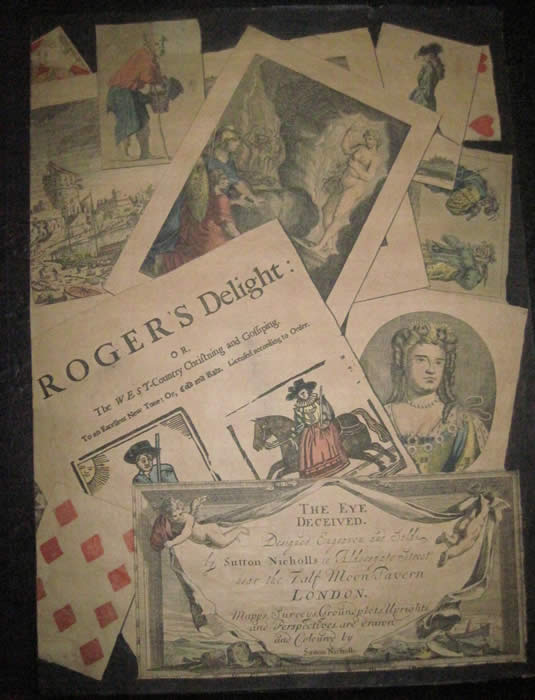
| THE EYE DECEIVED |
|---|
 |
4. (ENGRAVING-TROMPE L'OEIL) NICHOLLS, Sutton. THE EYE DECEIVED. DESIGNED ENGRAVED AND SOLD BY SUTTON NICHOLLS ON ALDERSGATE STREET NEAR THE HALF MOON TAVERN, LONDON. MAPPS, SURVEYS, GROUNDPLOTS, UPRIGHTS, AND PERSPECTIVES, ARE DRAWN AND COLOURED BY SUTTON NICHOLLS.
London: (circa 1710). Folio (14 1/4 x 10 1/4 inches). Single engraved and hand-colored plate.
An unusual trompe l'oeil engraved, printed and hand-colored plate by Sutton Nicholls. It depicts a printed and colored song sheet "Roger's Delight," with a scattering of playing cards and selection of prints on various subjects randomly placed. It is titled in the square cartouche in the lower right corner The Eye Deceived, and appears to be a promotion for his engraving business which had moved to Aldersgate Street. (See Clayton, The English Print, pp. 21 & 78).
He was a draughtsman and engraver who flourished between 1680 and 1740. Throughout his career, Nicholls specialized in topographical designs and architectural elevations, many of which he either engraved or etched himself. He was repeatedly employed to produce illustrations for antiquarian accounts and topographical surveys of London. In 1724 he contributed a view of London Bridge to David Mortier's long-term publishing project entitled Nouveau Theatre de la Grande Bretagne (1707-1726), which was a continuation of an original corpus of plates produced by Johannes Kip and Leonard Knyff in 1707. Nicholl's best works are his modest bird's-eye views of London squares and buildings published by John Bowles as Prospects of the Most Noted Buildings in and about London (1724). He also was the engraver and draughtsman for a number of maps by Philip Lea, Robert Morden, James Moxon, John Thornton, Henry Overton, John and Thomas Bowles and Edward Wells, including, "A New Map of the most considerable Plantations of the English in America...1701-1702."
Few details are known of his life, but in 1713 George Vertue included his name in a list of "ye engravers or impres-gravers burinators, sculpture-engravers in London." As he worked almost exclusively for book publishers, the clearest picture of Nicholl's career can be derived from the various publications with which his name is associated. The first of these is Philip Ayres' Emblems of Love in Four Languages, which was published in 1683 by Henry Overton, who continued to employ Nicholls until at least 1739. A few isolated examples, such as a greeting card designed for the parishioners of Shoreditch in 1695 and a series of grotesque emblematic plates illustrating the twelve months of the year, prove that he also took on jobbing work. This unusual print is a rare example of his independently produced work.
SOLD